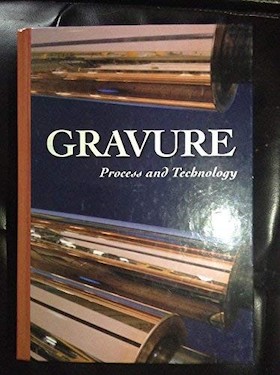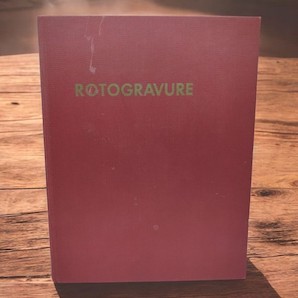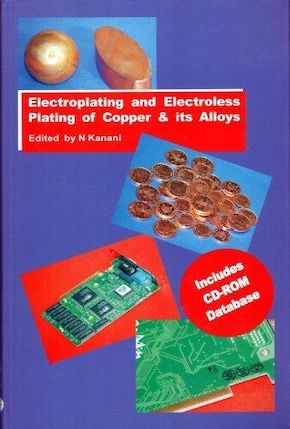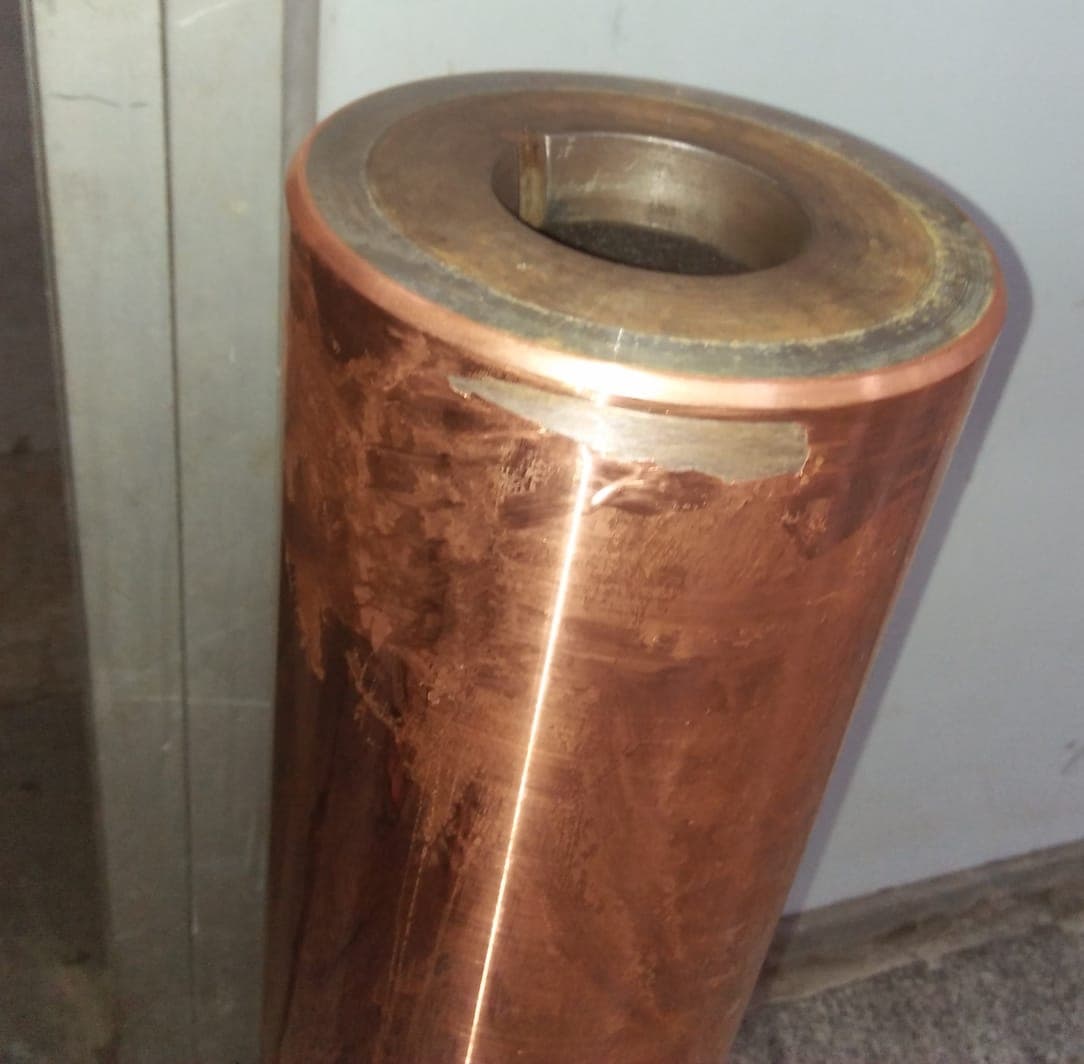
-----
Copper plating on gravure cylinders Q&A's Problems & Solutions
Q. Dear sir,
re. copper plating on gravure cylinders.
conc. of CuSO4 : 210 gm/ltr
conc. of H2SO4 : 65 gm/ltr
tank capacity : 1075 ltr
I have to know that what would be the issues if:
if CuSO4 is too high ?
if CuSO4 is too low?
if H2SO4 is too high?
if H2SO4 is too low?
And how do hardness additives work?
- Rudrapur, Uttarakhand, India
March 13, 2010
by Gravure Education Foundation

on eBay or Amazon
or AbeBooks
(affil link)
A. Dear Komal,
Each microstructural change caused by improper process parameters will immediately also change your engraving properties, which means shorter life-time of diamonds and bad shaped cells. Many providers in the rotogravure industry offers courses in electroplating for the rotogravure industry which, I am absolutely sure, won't leave any questions open ... anyhow, some answers to your questions:
Too low in Copper sulphate: Lower efficiency, bad distribution of copper deposition over the whole cylinder, burning on cylinder radius
Too high in Copper sulphate: Roughness, Brittle deposits, Crystallization
Too low sulfuric Acid: Bad conductivity, low hardness, low ductility
Too high sulfuric Acid: Higher hardness of deposits, brittle deposits, lower ductility
Additives in use are grain refiners. Hardness can be well adjusted, maintained and controlled over the dosage of these additives via Amp-hour dosing.
- Sydney, Australia
Q. I'm getting very low copper plating efficiency on the cylinder.
Current density is 25 Amps per dm2 and flowing current is equal to required current. H2SO4 & CuSO4 concentration is okay.
how can I get maximum copper plating efficiency?
- Rudrapur, Uttarakhand, India
March 29, 2010
A. Sir,
Something is not clear. copper sulphate
⇦ on
eBay or
Amazon [affil link] baths have an efficiency close to 100%. If your efficiency was very low the copper concentration should not be OK but rising. Perhaps you mean speed of deposition. In that case, carefully raise temperature and current and observe results.
Monterrey, NL, Mexico
A. Hello Komal,
Copper electrolytes, as mentioned by my mexican colleague, work with almost 100% efficiency.
Some hints:
- If your thickness over the cylinder is uneven, then you might have a problem with the level of amount copper nuggets in your cylinders plating tank. Archived distance between cylinder and copper anode should be around 30-50 mm.
- Do not raise temperature above 32 °C since this will cause a higher consumption of you hardness additive.
- Check you voltage at working current.
- Are you sure you are working with effective 25 A/dm2? If you are not sure, then I recommend a measurement on your rectifier shunt during copper plating. Measure the mV-Signal and re-calculate the real current.
- Are all contacts in order? Check carbon brushes on each side, or in case you have a cylinder plating tank with pinholes, then check the pinholes are not damaged and providing a good current flow.
Regards,
- Sydney, Australia
Q. Thank you Mr. Dominik Michalek for the help.
- Thickness over the cylinder is even.
- The amount of copper nuggets is maximum in cylinder plating tank.
- Archived distance between cylinder and copper anode is around 30-50 mm.
- I'm working with 25 A/ dm2.
- Getting voltage = 6 Volt at working current of every cylinder.
Should I increase voltage & how much?
- RUDRAPUR, UTTARAKHAND, INDIA
April 3, 2010
A. Hello Komal,
you are fine with 6 Volts at working current. Higher Voltage will increase temperature of your electrolyte and, if chilling system at your company doesn't work properly, will negatively affect your hardening additive and therefore the microcrystaline structure of the deposited copper. Try to keep your sulfuric acid at an concentration between 62 and 65 g/l. copper sulphate better on 210-230 g/l.
Greetings,
- Melbourne, Australia
Q. Sir,
Last few months I'm observing that when I add sulfuric acid in tank to maintain concentration, next plated cylinder hardness suddenly decreases -- why?
- Rudrapur, Uttarakhand, India
April 29, 2010
A. Probably because of the temperature rise. Sulfuric is very exothermic.
James Watts- Navarre, Florida
A. Hello Komal,
the drop of the hardness is, as mentioned by James, caused by the heat generated by adding the sulfuric acid. Obviously, depends on the amount of sulfuric acid which is added.
Regards,
Dominik
- Melbourne, Australia
Q. Dear sir,
I have a very good electrolyte chilling system for M/C. I operate my M/C 28 °C. When sulfuric acid is added then hardness suddenly decreases. Concentration is maintained daily by adding 1 liter of H2SO4. Daily we face hardness problem. Please suggest.
Does H2SO4 react with hardness additive and how?
- Rudrapur, Uttarakhand, India
June 3, 2010
A. Hi Komal.
In my previous posts I have already written to you what can cause the hardness drop/increase. Therefore I recommend to you the following:
- Make small additions of sulfuric acid.
- Re-adjust your electrolyte temperature from 28 to 30°C.
- Re-adjust your dosing amount of hardness additive.
- Since it costs you quite lot of money re-doing the cylinders due of low hardness I recommend to you to automate as much as possible your dosings.
- I expect that you use DI-Water with a conductivity of less then 10 microSiemens.
Good Luck
- Melbourne, Australia
Q. Thanks Dominik Michalek,
I observed that hardness of the copper plated cylinder increases with decrement of H2SO4 concentration.
Can anyone explain why?
Thanks
- Rudrapur, Uttarakhand, India
July 30, 2010
A. Copper coating can be done on cylinders by thermal spray.
The thickness limitation is not there in thermal spray and good results can be achieved. We can undertake TWAS (twin wire arc spray) coating of copper on cylinders.
- Bareilly, UP, India
by Herbert Mills Cartwright
 on eBay or
Amazon
on eBay or
Amazon
or AbeBooks
(affil link)
A. Hi Komal,
You have to try to understand the co-relation/function between all your physical and chemical parameters such as
- CD
- Temperature
- Additive dosage, effective amount
- Contamination by drag-ins and/or bad DI-Water quality (if existing)
- Filter system
- Calibration/Make of hardness measurement system
- Area of measurement
......and so on.
I think you should consider hiring a qualified Electroplater-/Engineer to solve your problems and if required, give an appropriate introduction to your process. In the end you'll save capital because, otherwise you have continuing high reject rates (process time, chemicals, nerves, diamond stylus breakage, etc.) caused by bad copper deposits made by lack of control of the whole process (which means also the thickness of substrate and base of substrate during measurement....).
I wish you the Best of Luck, Komal.
Cheers,
Dominik
- Sydney, Australia
![]() That sounded like a "goodbye" to this thread from Dominik, but I wanted to compliment and thank him for his patient and informative answers! Answering an initial question, then patiently following up 5 more times is yeoman work :-)
That sounded like a "goodbye" to this thread from Dominik, but I wanted to compliment and thank him for his patient and informative answers! Answering an initial question, then patiently following up 5 more times is yeoman work :-)
Regards,

Ted Mooney, P.E.
Striving to live Aloha
finishing.com - Pine Beach, New Jersey
Ted is available for instant help
or longer-term assistance.
Q. I'm facing dotting (pinhole) problem on gravure cylinder copper plating while machine is working at 20 ASD.
Please give suggestion?
Thanks.
- Rudrapur, Uttarakhand, India
May 14, 2011
Q. Dear Sir,
Now we have faced pinhole issues during the copper plating on cylinders.
Why did this problem come suddenly?
Filter candle changed after three mail days after 50 cylinders.
Please advise
plating shop employee - Rudrapur, UTTARAKHAND, India
January 13, 2015
-- 2nd Request
Q. Sir,
We are suddenly facing pinhole issues during the copper plating on cylinders.
Filter candle in good condition.
Chemical analysis is good.
Please advise.
plating shop employee - Rudrapur, UTTARAKHAND, India
January 17, 2015
A. It is because of copper additive , because earlier i am also facing the same problem but since i replaced old powder type additive with liquid type high speed copper additive; working condition @ CD 30 to 40 amp/dm2 temp 35 to 45 degree, this problem eliminated. Good surface & ductile deposition also reduce stylus consumption (1 stylus 280 Cyl) and printing issues like roughness, tail lines & lose of dots.
Rajeev Singyan- Delhi NCR India
July 9, 2023
Q. We have a problem on our copper plating machine for rotogravure printing cylinders.
Our data are : length 1370 mm, circ.672 mm, voltage 12,1 V, current 1421 Amp, temperature up to 33,9 °C. CD 25, Immersion 60%.
Are these data normal? Because the result is not good when engraved. It seems low hardness. Why does this happen? What are the maximum values for voltage, current, & temperature to get the best result?
Thank you.
- Kudus, Indonesia
February 23, 2018
Rotagravure copper plating is too soft
by N. Kanani

on eBay or Amazon
or AbeBooks
(affil link)
Q. We have a problem on our copper plating machine for rotogravure printing cylinders.
Our data are: voltage between 8-11 v depending on the cylinder size, temperature up to 33,9 °C. CD 25, Immersion 65%, sulfuric acid and copper sulphate conc respectively 65,230 g/L, hardener dosing pump conditions: 8.4 s working per 70 Ah current flow. DI water conductivity is less than 5 micro.s.
Are these data normal? Because it seems low hardness. We're increasing the hardener amount, so the problem gets solved for almost 5-7 cylinders. But hardness drop again lower than 180 hv. Why does this happen? It is worth noting that we have worked with mentioned conditions over 7 years and are now confronted with this problem.
Thank you.
- Tabriz, iran
July 6, 2018
Q. My situation: How to control pinholes in copper plating?
DHEERAJ JAISWALemployee - INDIA
August 17, 2018
Q. I am getting many pinholes and bulge of cylinder ... the concentration of H2SO4 is 65 and copper sulphate is 210-220 g/l ... current density we takes to machine 20-25 dm2 ...so suggest to me.

officer in in company - Noida, Uttar Pradesh, India...
Getting pinholes in copper plated cylinder
September 26, 2018Copper-only gravure cylinders for short runs?
Q. Is it technically possible to carry out short runs (5000 to 10000 meters) with only copper plated cylinders?
My question is because one of my customers has a lot of short runs and they have a production bottleneck at this moment.
I appreciate your answer.
packaging - Miami, Florida, USA
October 2, 2018
Ed. note: Folks!
This is a mutual-help forum which only works if people offer help to others, not just ask for help themselves :-)
That's 5 unanswered questions in a row :-(
Please offer some input to an open questions before posting your own or we're just being silly ... and calling yourself a rotagravure plater if you truly cannot contribute a single morsel to any question here? :-)
Thanks!
Q. We have a problem on our copper plating machine for rotogravure printing cylinders.
Our data are: voltage between 8-11 v depending on the cylinder size, temperature up to 33,9 °C. CD 25, Immersion 65%, sulfuric acid and copper sulphate conc, respectively 65,230 g/L, hardener dosing pump conditions: 8.4 s working per 70 Ah current flow. DI water conductivity is less than 5 micro.s.
Are these data normal? Because it seems low hardness. We're increasing the hardener amount, so the problem gets solved for almost 5-7 cylinders. But hardness drop again lower than 180 hv. Why does this happen? It is worth noting that we have worked with mentioned conditions over 5 years and are now confronted with this problem.
Thank you.
- Mumbai, Maharashtra , India
October 6, 2018
A. Hi Ravi, Set your dosing pump somewhere @ 7 Ah, 4 Second. Measure the additive quantity by removing hardener pipe from tank, connecting to beaker [beakers on eBay or Amazon [affil link] , checking the volume. It should be 1000 Amp-hour consumes 150 ml to 190 ml (100Ah: 16 to 18 ml)
Rajeev Singyan- Delhi NCR, India
July 9, 2023
Q. What should be the appropriate copper plating thickness for gravure cylinder?
Tauseef Ahmed- Karachi Sindh
September 24, 2020
Q, A, or Comment on THIS thread -or- Start a NEW Thread